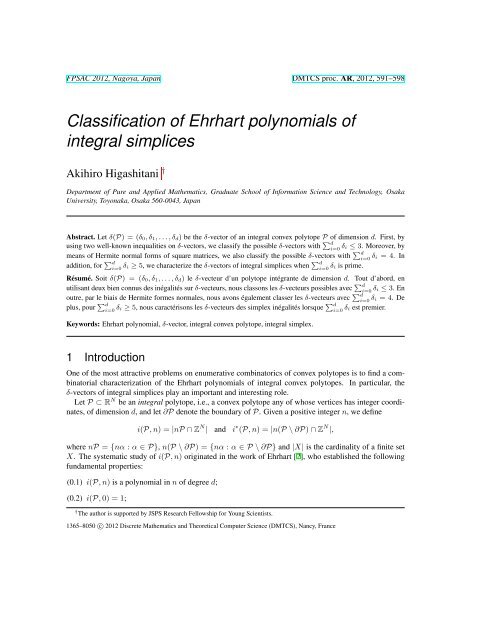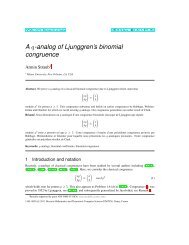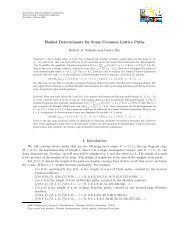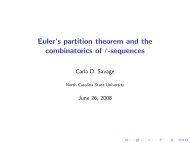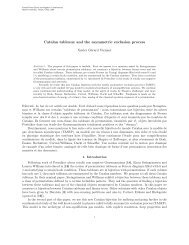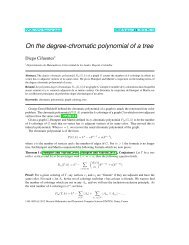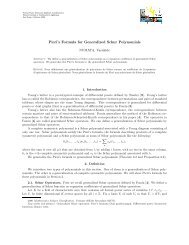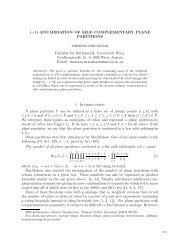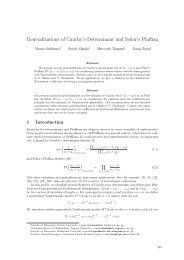Classification of Ehrhart polynomials of integral simplices - Nagoya ...
Classification of Ehrhart polynomials of integral simplices - Nagoya ...
Classification of Ehrhart polynomials of integral simplices - Nagoya ...
You also want an ePaper? Increase the reach of your titles
YUMPU automatically turns print PDFs into web optimized ePapers that Google loves.
FPSAC 2012, <strong>Nagoya</strong>, Japan DMTCS proc. AR, 2012, 591–598<strong>Classification</strong> <strong>of</strong> <strong>Ehrhart</strong> <strong>polynomials</strong> <strong>of</strong><strong>integral</strong> <strong>simplices</strong>Akihiro Higashitani †Department <strong>of</strong> Pure and Applied Mathematics, Graduate School <strong>of</strong> Information Science and Technology, OsakaUniversity, Toyonaka, Osaka 560-0043, JapanAbstract. Let δ(P) = (δ 0, δ 1, . . . , δ d ) be the δ-vector <strong>of</strong> an <strong>integral</strong> convex polytope P <strong>of</strong> dimension d. First, byusing two well-known inequalities on δ-vectors, we classify the possible δ-vectors with ∑ di=0δi ≤ 3. Moreover, bymeans <strong>of</strong> Hermite normal forms <strong>of</strong> square matrices, we also classify the possible δ-vectors with ∑ di=0δi = 4. Inaddition, for ∑ di=0 δi ≥ 5, we characterize the δ-vectors <strong>of</strong> <strong>integral</strong> <strong>simplices</strong> when ∑ di=0δi is prime.Résumé. Soit δ(P) = (δ 0, δ 1, . . . , δ d ) le δ-vecteur d’un polytope intégrante de dimension d. Tout d’abord, enutilisant deux bien connus des inégalités sur δ-vecteurs, nous classons les δ-vecteurs possibles avec ∑ di=0δi ≤ 3. Enoutre, par le biais de Hermite formes normales, nous avons également classer les δ-vecteurs avec ∑ di=0δi = 4. Deplus, pour ∑ di=0 δi ≥ 5, nous caractérisons les δ-vecteurs des simplex inégalités lorsque ∑ di=0δi est premier.Keywords: <strong>Ehrhart</strong> polynomial, δ-vector, <strong>integral</strong> convex polytope, <strong>integral</strong> simplex.1 IntroductionOne <strong>of</strong> the most attractive problems on enumerative combinatorics <strong>of</strong> convex polytopes is to find a combinatorialcharacterization <strong>of</strong> the <strong>Ehrhart</strong> <strong>polynomials</strong> <strong>of</strong> <strong>integral</strong> convex polytopes. In particular, theδ-vectors <strong>of</strong> <strong>integral</strong> <strong>simplices</strong> play an important and interesting role.Let P ⊂ R N be an <strong>integral</strong> polytope, i.e., a convex polytope any <strong>of</strong> whose vertices has integer coordinates,<strong>of</strong> dimension d, and let ∂P denote the boundary <strong>of</strong> P. Given a positive integer n, we definei(P, n) = |nP ∩ Z N | and i ∗ (P, n) = |n(P \ ∂P) ∩ Z N |,where nP = {nα : α ∈ P}, n(P \ ∂P) = {nα : α ∈ P \ ∂P} and |X| is the cardinality <strong>of</strong> a finite setX. The systematic study <strong>of</strong> i(P, n) originated in the work <strong>of</strong> <strong>Ehrhart</strong> [2], who established the followingfundamental properties:(0.1) i(P, n) is a polynomial in n <strong>of</strong> degree d;(0.2) i(P, 0) = 1;† The author is supported by JSPS Research Fellowship for Young Scientists.1365–8050 c○ 2012 Discrete Mathematics and Theoretical Computer Science (DMTCS), Nancy, France
594 Akihiro Higashitani3 Two well-known inequalities on δ-vectorsIn this section, we present two well-known inequalities on δ-vectors. By using them, we give the completeclassification <strong>of</strong> the possible δ-vectors <strong>of</strong> <strong>integral</strong> convex polytopes with ∑ di=0 δ i ≤ 3.Let s = max{i : δ i ≠ 0}. Stanley [11] shows the inequalitiesδ 0 + δ 1 + · · · + δ i ≤ δ s + δ s−1 + · · · + δ s−i , 0 ≤ i ≤ [s/2] (3)by using the theory <strong>of</strong> Cohen–Macaulay rings. On the other hand, the inequalitiesδ d + δ d−1 + · · · + δ d−i ≤ δ 1 + δ 2 + · · · + δ i+1 , 0 ≤ i ≤ [(d − 1)/2] (4)appear in [4, Remark (1.4)]. A pro<strong>of</strong> <strong>of</strong> the inequalities 4 is given by using combinatorics on convexpolytopes.Somewhat surprisingly, when ∑ di=0 δ i ≤ 3, the above inequalities 3 together with 4 give a characterization<strong>of</strong> the possible δ-vectors. In fact,Theorem 3.1 Given a finite sequence (δ 0 , δ 1 , . . . , δ d ) <strong>of</strong> nonnegative integers, where δ 0 = 1, which satisfies∑ di=0 δ i ≤ 3, there exists an <strong>integral</strong> convex polytope P ⊂ R d <strong>of</strong> dimension d whose δ-vectorcoincides with (δ 0 , δ 1 , . . . , δ d ) if and only if (δ 0 , δ 1 , . . . , δ d ) satisfies all inequalities 3 and 4. Moreover,all <strong>integral</strong> convex polytopes can be chosen to be <strong>simplices</strong>.Note that the “Only if” part <strong>of</strong> Theorem 3.1 is obvious. Thus we may show the “If” part. Moreover,when ∑ di=0 δ i = 1, it is obvious that the possible sequence is only (1, 0, . . . , 0) and this is a δ-vector <strong>of</strong>some <strong>integral</strong> convex polytope, in particular, <strong>integral</strong> simplex. A sketch <strong>of</strong> a pro<strong>of</strong> <strong>of</strong> the “If” part with∑ di=0 δ i = 2 or 3 is as follows:• When ∑ i=0 δ i = 2, the possible integer sequence looks like (1, 0, . . . , 0,}{{}1 , 0, . . . , 0) ∈ Z d+1 ,iwhere}{{}1 means that δ i = 1. On the other hand, we have i ≤ ⌊(d + 1)/2⌋ by 4. Hence we mayifind an <strong>integral</strong> convex polytope, in particular, an <strong>integral</strong> simplex, whose δ-vector coincides withthat. Note that we may construct such simplex with i = ⌊(d + 1)/2⌋ by virtue <strong>of</strong> Lemma 2.2.• When ∑ i=0 δ i = 3, we have two candidates <strong>of</strong> the possible integer sequences.– When (1, 0, . . . , 0,}{{}2 , 0, . . . , 0) ∈ Z d+1 , similar discussions to the previous case can beiapplied.– When (1, 0, . . . , 0,}{{}1 , 0, . . . , 0,}{{}1 , 0, . . . , 0) ∈ Z d+1 , from 3 and 4, we have the inequalitiesij1 ≤ i < j ≤ d, 2i ≤ j and i + j ≤ d + 1.Once we can find an <strong>integral</strong> simplex whose δ-vector coincides with that with 2i = j andi+j = d+1, we can also construct an <strong>integral</strong> simplex whose δ-vector is that for any integersi and j with the above inequalities.
596 Akihiro HigashitaniTheorem 4.1 Let 1 + t i1 + t i2 + t i3 be a polynomial in t with 1 ≤ i 1 ≤ i 2 ≤ i 3 ≤ d. Then there exists an<strong>integral</strong> convex polytope P ⊂ R d <strong>of</strong> dimension d whose δ-polynomial coincides with 1 + t i1 + t i2 + t i3 ifand only if (i 1 , i 2 , i 3 ) satisfiesand an additional conditioni 3 ≤ i 1 + i 2 , i 1 + i 3 ≤ d + 1, i 2 ≤ ⌊(d + 1)/2⌋ (5)2i 2 ≤ i 1 + i 3 or i 2 + i 3 ≤ d + 1. (6)Moreover, all <strong>integral</strong> convex polytopes can be chosen to be <strong>simplices</strong>.Note that the inequalities 5 follow from the inequalities 3 and 4, that is to say, the condition 5 isautomatically a necessary condition. Thus, the condition 6 is the new necessary condition on δ-vectorswhen ∑ di=0 δ i = 4.A sketct <strong>of</strong> a pro<strong>of</strong> <strong>of</strong> this theorem is as follows:• On the “If” part, we may construct <strong>integral</strong> <strong>simplices</strong> whose δ-<strong>polynomials</strong> look like 1+t i1 +t i2 +t i3satisfying 5 and 6. By characterizing the possible δ-vectors <strong>of</strong> all the <strong>integral</strong> <strong>simplices</strong> arising fromthe Hermite normal forms M with det(M) = 4, we can find such <strong>integral</strong> <strong>simplices</strong>.• On the “Only if” part, we may show that if a polynomial 1 + t i1 + t i2 + t i3 satisfies 5 but doesnot satisfy 6, then i 1 > 1, i.e., an <strong>integral</strong> convex polytope with this δ-polynomial is always asimplex. By characterizing the possible δ-vectors <strong>of</strong> all the <strong>integral</strong> <strong>simplices</strong> arising from theHermite normal forms M with det(M) = 4, we can say that there exists no <strong>integral</strong> simplex whoseδ-polynomial is equal to 1 + t i1 + t i2 + t i3 not satisfying 6.Example 4.2 As we see in Example 3.2, the integer sequence (1, 0, 1, 0, 1, 1, 0, 0) cannot be the δ-vector<strong>of</strong> any <strong>integral</strong> convex polytope <strong>of</strong> dimension 7. In fact, since 8 = 2i 2 > i 1 + i 3 = 7 and 9 = i 2 + i 3 > 8,there exists no <strong>integral</strong> convex polytope <strong>of</strong> dimension 7 whose δ-polynomial is 1+t 2 +t 4 +t 5 . On the otherhand, there exists an <strong>integral</strong> convex polytope <strong>of</strong> dimension 8 whose δ-vector is (1, 0, 1, 0, 1, 1, 0, 0, 0)since 9 = i 2 + i 3 = d + 1.Remark 4.3 We see that all the possible δ-vectors can be obtained by <strong>integral</strong> <strong>simplices</strong> when ∑ di=0 δ i ≤4. However, the δ-vector (1, 3, 1) cannot be obtained from any <strong>integral</strong> simplex, while this is a possibleδ-vector <strong>of</strong> some <strong>integral</strong> convex polytope <strong>of</strong> dimension 2. In fact, suppose that (1, 3, 1) can be obtainedfrom a simplex. Since min{i : δ i ≠ 0, i > 0} = 1 and max{i : δ i ≠ 0} = 2, one has min{i : δ i ≠ 0, i >0} = 3 − max{i : δ i ≠ 0}, which implies that the assumption <strong>of</strong> [5, Theorem 2.3] is satisfied. Thus theδ-vector must be shifted symmetric, a contradiction.5 <strong>Ehrhart</strong> <strong>polynomials</strong> <strong>of</strong> <strong>integral</strong> <strong>simplices</strong> with prime volumesFrom the previous two sections, we know that all the possible δ-vectors with ∑ di=0 δ i ≤ 4 can be obtainedby <strong>integral</strong> <strong>simplices</strong>, while this does not hold when ∑ di=0 δ i = 5. Therefore, for the further classifications<strong>of</strong> the δ-vectors with ∑ di=0 δ i ≥ 5, it is natural to investigate the δ-vectors <strong>of</strong> <strong>integral</strong> <strong>simplices</strong>. In this
<strong>Classification</strong> <strong>of</strong> <strong>Ehrhart</strong> <strong>polynomials</strong> <strong>of</strong> <strong>integral</strong> <strong>simplices</strong> 597section, we establish the new equalities and inequalities on δ-vectors for <strong>integral</strong> <strong>simplices</strong> when ∑ di=0 δ iis prime. Moreover, by using them, we classify all the possible δ-vectors <strong>of</strong> <strong>integral</strong> <strong>simplices</strong> with∑ di=0 δ i = 5 and 7.The following equalities or inequalities are new constraints on the δ-vectors <strong>of</strong> <strong>integral</strong> <strong>simplices</strong> when∑ di=0 δ i is prime.Theorem 5.1 Let P ⊂ R N be an <strong>integral</strong> simplex <strong>of</strong> dimension d and δ(P) = (δ 0 , δ 1 , . . . , δ d ) its δ-vector. Suppose that ∑ di=0 δ i = p is an odd prime number. Let i 1 , . . . , i p−1 be the positive integers suchthat ∑ di=0 δ it i = 1 + t i1 + · · · + t ip−1 with 1 ≤ i 1 ≤ · · · ≤ i p−1 ≤ d. Then(a)i 1 + i p−1 = i 2 + i p−2 = · · · = i (p−1)/2 + i (p+1)/2 ≤ d + 1;(b)i k + i l ≥ i k+l for 1 ≤ k ≤ l ≤ p − 1 with k + l ≤ p − 1.Example 5.2 When ∑ di=0 δ i is not prime, Theorem 5.1 is not true. In fact, by virtue <strong>of</strong> Theorem 4.1,(1, 1, 0, 2, 0, 0) is the δ-vector <strong>of</strong> some <strong>integral</strong> simplex <strong>of</strong> dimension 5. However, one has 2 = i 1 + i 1
598 Akihiro HigashitaniReferences[1] M. Beck and S. Robins, “Computing the Continuous Discretely,” Undergraduate Texts in Mathematics,Springer, 2007.[2] E. <strong>Ehrhart</strong>, “Polynômes Arithmétiques et Méthode des Polyèdres en Combinatoire,” Birkhäuser,Boston/Basel/Stuttgart, 1977.[3] T. Hibi, “Algebraic Combinatorics on Convex Polytopes,” Carslaw Publications, Glebe NSW, Australia,1992.[4] T. Hibi, A lower bound theorem for <strong>Ehrhart</strong> <strong>polynomials</strong> <strong>of</strong> convex polytopes, Adv. in Math. 105(1994), 162 – 165.[5] A. Higashitani, Shifted symmetric δ-vectors <strong>of</strong> convex polytopes, Discrete Math. 310 (2010), 2925–2934.[6] M. B. Nathanson, “Additive number theory, inverse problems and the geometry <strong>of</strong> subsets,”Springer–Verlag, 1996.[7] A. Schrijver, “Theory <strong>of</strong> Linear and Integer Programming,” John Wiley & Sons, 1986.[8] P. R. Scott, On convex lattice polygons, Bull. Austral. Math. Soc. 15 (1976), 395 – 399.[9] R. P. Stanley, Decompositions <strong>of</strong> rational convex polytopes, Annals <strong>of</strong> Discrete Math. 6 (1980), 333– 342.[10] R. P. Stanley, “Enumerative Combinatorics, Volume 1,” Wadsworth & Brooks/Cole, Monterey,Calif., 1986.[11] R. P. Stanley, On the Hilbert function <strong>of</strong> a graded Cohen–Macaulay domain, J. Pure and Appl.Algebra 73 (1991), 307 – 314.


